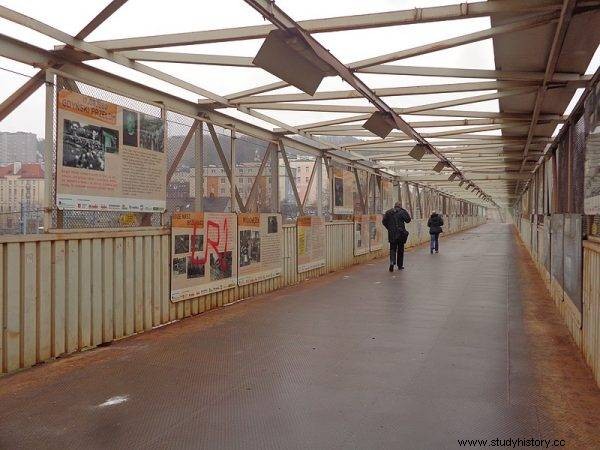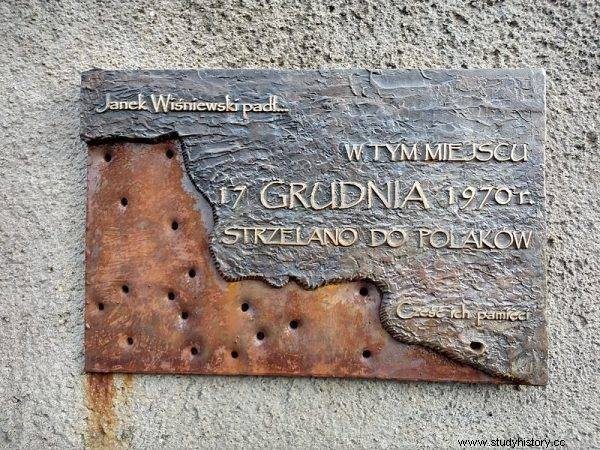Black Thursday - one of the most tragic days in the communist era. Politicians who ruled in the name of workers ordered soldiers to shoot people going to work.
Protests against rising food prices had lasted several dozen hours in the Coast, when Deputy Prime Minister Stanisław Kociołek on the evening of December 16 called on workers to return to work. Finishing his appeal, he said:“Once again, shipyard workers, the appeal addressed to you - start your normal work! There are conditions for this, it is also necessary to be able to celebrate and welcome the New Year in peace soon. "
In Gdynia, many people listened to him. From the early morning hours of December 17, employees of the Shipyard Of the Paris Commune. The loudspeakers announced that the shipyard was closed, but many ignored the signal.
One of the shipyard workers in a management position, Wojciech Szwoch, was on the train to work around 6.00 am, when the train "rocked". A tank fired at him. In those days, about 350 tanks and 600 transporters were sent to the streets in Gdynia and Gdańsk - as if they were getting ready for a serious battle.
On the way to the Shipyard For more than an hour, the Paris Commune had to face a military blockade supported by militiamen. Historian Jerzy Eisler wrote that it was deliberately established in a place "from which, in the case of the use of weapons by the army and the militia, the people under fire would have nowhere to run away".
In fact, it was like that - trains brought employees from 5 am. It was still dark, the crowd walking along the overpass above the station could not see the blockade or the armored vehicles. The troops were commanded by Lieutenant Colonel Władysław Łomot from the 32nd Regiment of Mechanized Forces. He tried to stop the people, then ordered the tank to be shot into the air. The shipyard workers were confused. After all, the day before, television calls were made to go to work! A lot was probably also curious, there were also provocateurs or simply frivolous people. Most, however, were former laborers willing to work.
They carried him on Świętojańska Street
Finally, the shots were aimed at the people. It was 6:05 am. Initially, the army did not shoot at the crowd, but at the pavement - the missiles did bounce, however, and ricocheted also at those marching in the rear ranks.
Wojciech Drożak, then a 19-year-old shipyard worker, said:“And a woman was standing there for about 40 years and she was given these shards, these splinters, so that after the shot there was a scream, she fell over. Later, when the ambulances arrived, I saw her in the ambulance. She was still alive, but the sight was terrible, her face was massacred, her nose and eyes were not visible at all, scraps, just scraps from her face " .
Lieutenant Colonel Władysław Łomot was shocked, "temporarily losing even the ability to command the soldiers under his control" - issuing an order to shoot at defenseless people is probably not easy for anyone. This, plus the organizational chaos - because several centers commanded pacifying the workers in Gdynia - made the situation even worse. Various orders were also coming from Warsaw.

The army started shooting at people going to work (in the photo there is a footbridge over the Gdynia-Shipyard station).
Soon all hell broke loose. People grabbed the stones, even tried to set fire to the pier, but on a damp December morning, the fire did not catch. The fighting spilled over into other streets of the city. There and back were militia cars firing firecrackers and chemical grenades. From 6:35 am, helicopters dropping chemicals flew over the buildings. Later, there were also reports that they were shot at people ...
Stanisław Kodzik, then a student of one of Gdynia's schools, recalled:“ The fights have begun. Once they were, we were pushing them away again. Little boys flew with buckets of water and choked firecrackers. Boys in the army ran next to them and made sure that they did not pick up the firecrackers, because they might tear their hands. Lots of firecrackers were thrown back into militiamen. ”
Probably everyone has heard "Ballade about Janek Wiśniewski" - be it performed by Krystyna Janda or recently by Kazik Staszewski - or watched a moving, though for many iconoclastic, scene from "Psy", when drunk SS women carry a friend while singing a ballad. It is known that Janek Wiśniewski is a fictional character (perhaps his prototype was 18-year-old Zbigniew Godlewski), but the whole song perfectly reflects those tragic moments. In Gdynia, the first procession was formed already at 7.00 am, then the second and subsequent ones. People sang the Polish national anthem, but also workers' songs and the International.
According to the account of one of the women, nurse Eleonora Karczewska, who saw such a march:“a few men carried a young boy on the door. His neck was bloody, it looked terrible (...). The boy was transparently pale, blonde with short hair, such a kid. " A record of several hours of conversations conducted by MO officers, recorded by an amateur of walkie-talkies, has gone down in history:
Listen. This group with this, with this one, with the killed one, I am asking you, is in Świętojańska Street, already in Świętojańska Street. The banner is carried by a bloodied body and behind it this corpse (...) Come in Chestnut, Guyana here. This group with these flags and this corpse is headed by the youth. They say academic or school. They continue towards the presidium. (...).
Okay. Chestnut, Chestnut come in. The group that is carrying this corpse is currently on Świętojańska Street, at the height of PKO, and so far no measures are applied and there is a danger that this group may grow. . Because everyone is joining, joining, stopping, taking off their hats and crying (...) What about this corpse? Did they get him out of front of the presidency? - So listen, it's taken over by ours, it's taken over by ours and you can't see anything there.
Burials at night
In total, the balance of deaths that day in Gdynia - according to official data - was 18 people, but there were already hundreds of injured. Many people never regained their full fitness due to gunshots - also because they were afraid to go to hospitals. A separate category is made up of people who were beaten in the building of the Presidium of the City National Council - this is where the militia established a torture chamber.

Commemorative plaque at the December Victims Junction in Gdynia.
Such a scale of repression must be surprising, especially since in Gdynia itself, workers' protests after the increases were peaceful - it was in Gdańsk that riots took place. There were also no looting, which unfortunately happened in Gdańsk. There were also deaths (16 to be exact) in Szczecin, where fierce fighting took place - the building of the Provincial Committee was set on fire. When the Political Bureau of the Central Committee of the Polish United Workers' Party met on December 17 at noon, Mieczysław Moczar informed about the events in Szczecin:“The situation was very dangerous, there was a sharp clash with an aggressive crowd of over 2,000. people, there were numerous arson attacks, gas bombs were used ”.
Gomułka's answer, despite the passage of years, is still terrifying:"Where they set it on fire, you have to shoot".
Several officers and soldiers were also killed on the side of the army and militia. They were injured. Stanisław Kociołek spoke at a meeting of the Political Bureau of the Central Committee of the Polish United Workers' Party on December 19 about 300 injured policemen. He also stated that "confusion creeps into military families." Fears arise in the military as to whether they are defending a just cause. ”
When the fighting ceased, the drama of the victims' families began. At that time, it was not easy to find out where your loved ones were - did they die? Maybe they are in the hospital? In what condition? Those who were under medical care were visited by the police. Those who died were buried at night, in the light of police lights in anonymous graves .
The father of the killed Janusz Żebrowski said:“the son did not come home one day, the next day; I'm walking; I ask those who were released from detention, from prisons - no one saw it. Eventually, Żebrowski helped Żebrowski find his son's grave to find a policeman he knew. It turned out that Janusz was buried in Gdańsk. The tomb was without a plaque, but with a cross. It was only in spring that the family of the deceased got permission to be exhumed. Tomasz Żebrowski placed the words "He was shot by MO in the December incidents" on the new grave. Later, unknown perpetrators blurred the inscription. So Tomasz Żebrowski wrote it again. And they are alone again. Only after the monument was erected, the grave was left alone.
